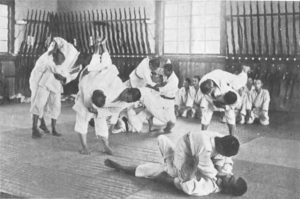Pagpapakita ng Ju-Jitsu
Yukio Tani arrived in England at the turn of the 20ika Century. Ipinakalat ni Tani ang ju-jitsu sa pamamagitan ng pakikilahok sa mga laban sa hamon laban sa mga propesyonal na wrestler. Bilang bahagi ng mga tugmang hamon na ito, Nagpakita si Tani ng ju-jitsu. Sa pamamagitan ng tagumpay ng mga hamon at demonstrasyon na ito, Nakita ni Tani na maraming estudyante ang nag-sign up para magsanay kasama niya.
One of Tani’s best English students used the stage name Apollo, when he continued Tani’s tradition of challenges and demonstrations to spread the art. Sa Martes, Setyembre 4, 1906, Apollo gave a demonstration at the Hippodrome in Birmingham, Inglatera.

Jujitsu Practice at a Japanese Agricultural School in 1922 (Public Domain)
After Apollo showed holds with his students, Apollo offered to grapple with any local man. Apollo offered a cash prize to any local man, who could last two minutes without surrendering to Apollo’s ju-jitsu holds.
As often happens with these challenges, an English professional wrestler, who did not live in Birmingham, and had trained Ahmed Madrali for his match with George Hackenschmidt, challenged Apollo. Apollo accepted the challenge but demanded that the professional wrestler waive the two-minute time limit.
The wrestler agreed, so Apollo took the stage. After four minutes, twenty-five seconds, Apollo forced the Lancashire professional to give up to a ju-jitsu armlock.
After Apollo defeated the ring, an actual Birmingham wrestler, Mr. R. Ang. Duke took Apollo up on his offer. Apollo agreed to grapple with Mr. Duke on the following night. Apollo would give Mr. Duke one pound for every minute Duke lasted past the two-minute challenge time.
Through these challenges and demonstrations, instructors spread judo and ju-jitsu across the world. The Gracies would use a similar program to spread their style of jiu-jitsu in the United States during the 1980s and 1990s.
There is nothing new under the sun.
You can leave a comment or ask a question about this or any post on my Pahina ng Facebook.
Sources: Evening Despatch (Birmingham, Inglatera), Setyembre 5, 1906, p. 6
Pin Ito
